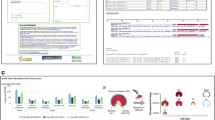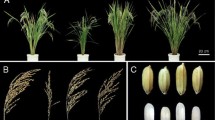Abstract
Single-nucleotide polymorphisms (SNPs) are useful markers for gene diagnosis and mapping of genes on chromosomes. However, polyploidy, which is characteristic of the evolution of higher plants, complicates the analysis of SNPs in the duplicated genes. We have developed a new method for SNP analysis in hexaploid wheat. First, we classified a large number of expressed sequence tags (ESTs) from wheat in silico. Those grouped into contigs were anticipated to correspond to transcripts from homoeologous loci. We then selected relatively abundant ESTs, and assigned these contigs to each of the homoeologous chromosomes using a nullisomic/tetrasomic series of Chinese Spring wheat strains in combination with pyrosequencing. The ninety genes assigned were almost evenly distributed into seven homologous chromosomes. We then created a virtual display of the relative expression of these genes. Expression patterns of genes from the three genomes in hexaploid wheat were classified into two major groups: (1) genes almost equally expressed from all three genomes; and (2) genes expressed with a significant preference, which changed from tissue to tissue, from certain genomes. In 11 cases, one of the three genes in the allopolyploid was found to be silenced. No preference for gene-silencing in particular genomes or chromosomes was observed, suggesting that gene-silencing occurred after polyploidization, and at the gene level, not at the chromosome or genome level. Thus, the use of this SNP method to distinguish the expression profiles of three homoeologous genes may help to elucidate the molecular basis of heterosis in polyploid plants.



Similar content being viewed by others
References
Adams KL, Cronn R, Percifield R, Wendel JF (2003) Genes duplicated by polyploidy show unequal contributions to the transcriptome and organ-specific reciprocal silencing. Proc Natl Acad Sci USA 100:4649–4654
Altschul SF, Gish W, Miller W, Myers EW, Lipman DJ (1990) Basic local alignment search tool. J Mol Biol 215:403–410
Altshuler D, Pollara VJ, Cowles CR, Van Etten WJ, Baldwin J, Linton L, Lander ES (2000) An SNP map of the human genome generated by reduced representation shotgun sequencing. Nature 407:513–516
Batley J, Baker G, O’Sullivan H, Edwards KJ, Edwards D (2003) Mining for single nucleotide polymorphisms and insertions/deletions in maize expressed sequence tag data. Plant Physiol 32:84–91
Buetow LH, Edmonson MN, Cassidy AG (1999) Reliable identification of large numbers of candidate SNPs from public EST data. Nature Genet 21:323–325
Cho RJ, et al (1999) Genome-wide mapping with biallelic markers in Arabidopsis thaliana. Nat Genet 23:203–207
Drenkard E, Richter BG., Rozen S, Stutius LM, Angell NA, Mindrinos M, Cho RJ, Oefner PJ, Davis RW, Ausubel FM (2000) A simple procedure for the analysis of single nucleotide polymorphisms facilitates map-based cloning in Arabidopsis. Plant Physiol 124:1483–1492.
Eisen MB, Spellman PT, Brown PO, Botstein D (1998) Cluster analysis and display of genome-wide expression patterns. Proc Natl Acad Sci USA 96:14863–14868
Ewing RM, Kahla AB, Poirot O, Lopez F, Audic S, Claverie J-M (1999) Large-scale statistical analysis of rice ESTs reveals correlated patterns of gene expression. Genome Res 9:950–959
Hoogendoorn B, Owen MJ, Oefner PJ, Williams N, Austin J, O’Donovan MC (1999) Genotyping single nucleotide polymorphisms by primer extension and high performance liquid chromatography. Hum Genet 104:89–93
Kanazin V, Talbert H, See D, DeCamp P, Nevo E, Blake T (2002) Discovery and assay of single-nucleotide polymorphisms in barley ( Hordeum vulgare). Plant Mol Biol 48:529–537
Lange C, Whittaker JC (2001) On prediction of genetic values in marker-assisted selection. Genetics 159:1375–1381
Leitch IJ, Bennett MD (1997) Polyploidy in angiosperms. Trends Plant Sci 2:470–476
Lilienfeld FA (1951) H Kihara: Genome analysis in Triticum and Aegilops. X Concluding review. Cytologia 16:101–123
Makridakis NM, Reichardt JKV (2001) Multiplex automated primer extension analysis: simultaneous genotyping of several polymorphisms. Biotechniques 31:1374–1380
Masterson J (1994) Stomatal size in fossil plants: evidence for polyploidy in the majority of angiosperms. Science 264:421–424
Nemoto Y, Kisaka M, Fuse T, Yano M, Ogihara Y (2003) Characterization of three wheat genes with homology to the CONSTANS flowering time gene and analysis of their function in transgenic rice. Plant J 36:82–93
Ogihara Y, Hasegawa K, Tsujimoto H (1994) High-resolution cytological mapping of the long arm of chromosome 5A in common wheat using a series of deletion lines induced by gametocidal ( Gc) genes of Aegilops speltoides. Mol Gen Genet 244: 253–259
Ogihara Y, Mochida K, Nemoto Y, Murai K, Yamazaki Y, Shin-I T, Kohara Y (2003) Correlated clustering and virtual display of gene expression patterns in the wheat life cycle by large-scale statistical analyses of expressed sequence tags. Plant J 33:1001–1011
Ozkan H, Levy AA, Feldman M (2001) Allopolyploidy-induced rapid genome evolution in the wheat ( Aegilops-Triticum) group. Plant Cell 13:1735–1747
Picoult-Newberg L, Ideker TE, Pohl MG., Taylor SL, Donaldson MA, Nickerson DA, Boyce-Jacino M (1999) Mining SNPs from EST databases. Genome Res 9: 167–174
Rickert AM, Premstaller A, Gebhardt C, Oefner PJ (2002) Genotyping of SNPs in a polyploid genome by pyrosequencing. Biotechnology 32:592–603
Scheid OM, Probst AV, Afsar K, Paszkowski J (2002) Two regulatory levels of transcriptional gene silencing in Arabidopsis. Proc Natl Acad Sci USA 99:13659–13662
Sears ER (1965) Nullisomic-tetrasomic combinations in hexaploid wheat. In: Riley R, Lewis KR (eds) Chromosome manipulation and plant genetics. Oliver and Boyd, Edinburgh, pp 29–58
Shaked H, Kashkush K, Ozkan H, Feldman M, Levy AA (2001) Sequence elimination and cytosine methylation are rapid and reproducible responses of the genome to wide hybridization and allopolyploidy in wheat. Plant Cell 13:1749–1759
Soltis DE, Soltis PS (1999) Polyploidy: origins of species and genome evolution. Trends Ecol Evol 9:348–352
Soltis PS, Soltis DE (2000) The role of genetic and genomic attributes in the success of polyploids. Proc Natl Acad Sci USA 97:7051–7057
Taillon-Miller P, Gu Z, Li Q, Hillier L, Kwok PY (1998) Overlapping genomic sequences: a treasure trove of single-nucleotide polymorphisms. Genome Res 8:748–754
Tsunewaki K (1993) Genome-plasmon interaction in wheat. Jpn J Genet 68:1–34
Van Campenhout S, Sagi L, Vander Stappen J, Volckaert G (1998) Characterization of type-I thionin loci from the A, B, D and R genomes of wheat and rye. Theor Appl Genet 96:80–86
Vision T J, Brown DG, Tanksley SD (2000) The origins of genomic duplications in Arabidopsis. Science 290:2114–2117
Wendel JF (2000) Genome evolution in polyploids. Plant Mol Biol 42:225–249
Yu J, et al (2002) A draft sequence of the rice genome ( Oryza sativa L. ssp. indica). Science 296:79–92
Acknowledgements
This work was supported by Grants-in-Aid for Scientific Research on Priority Areas (C) “Genome Science” and Basic Research (A) (Nos. 13202055 and 13356001) from the Ministry of Education, Culture, Sports, Science and Technology of Japan.
Author information
Authors and Affiliations
Corresponding author
Additional information
Communicated by R. Hagemann
Rights and permissions
About this article
Cite this article
Mochida, K., Yamazaki, Y. & Ogihara, Y. Discrimination of homoeologous gene expression in hexaploid wheat by SNP analysis of contigs grouped from a large number of expressed sequence tags. Mol Genet Genomics 270, 371–377 (2004). https://doi.org/10.1007/s00438-003-0939-7
Received:
Accepted:
Published:
Issue Date:
DOI: https://doi.org/10.1007/s00438-003-0939-7




